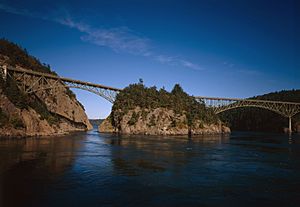Deception Pass Bridge facts for kids
Quick facts for kids Deception Pass Bridge |
|
|---|---|

Both Canoe Pass and Deception Pass Bridges, looking east
|
|
| Carries | |
| Crosses | Deception Pass, Canoe Pass |
| Locale | Oak Harbor, Washington |
| Heritage status | NRHP |
| Characteristics | |
| Design | Deck arch, cantilever |
| Material | Steel |
| Total length | 1,487 feet (453 m) |
| Width | 28 feet (8.5 m) |
| Longest span | 511 feet (156 m) |
| Clearance below | 180 feet (55 m) |
| History | |
| Construction begin | August 1934 |
| Inaugurated | July 1935 |
| Statistics | |
| Daily traffic | 20,000 cars |
|
Deception Pass Bridge
|
|

Deception Pass Bridge, connecting Whidbey Island to Pass Island.
|
|
| Location | SR 20 Island and Skagit counties, Washington, USA |
| Nearest city | Oak Harbor; Anacortes |
| Built | 1934-35 |
| MPS | Historic Bridges/Tunnels in Washington State TR |
| NRHP reference No. | 82004285 |
| Added to NRHP | July 16, 1982 |
The Deception Pass Bridge is a famous landmark in Washington State, USA. It's actually two bridges that connect Whidbey Island in Island County to Fidalgo Island in Skagit County. These islands are part of the beautiful Puget Sound region. The bridge carries Washington State Route 20, a busy road that helps people travel between the islands.
Building this bridge was a big deal! It helped the nearby town of Oak Harbor grow. It also played a part in building the Naval Air Station Whidbey Island. Many people love to visit and photograph this amazing bridge.
Contents
Discovering Deception Pass
In 1792, a British explorer named Joseph Whidbey was exploring the area. He was part of Captain Vancouver's team. They thought the narrow waterway was just a small bay. But Whidbey discovered it was actually a deep, fast-moving channel. Because it "deceived" them, they named it "Deception Pass." This channel connects the Strait of Juan de Fuca with the Saratoga Passage.
Before the bridge, crossing from Fidalgo Island to Whidbey Island was tricky. In the early 1900s, people used a small, unscheduled ferry. To call the ferry, they would hit a saw with a mallet and then wait for it to arrive.
Building the Bridge
The Deception Pass Bridge is actually made of two separate spans. One span crosses over Canoe Pass to the north. The other, longer span crosses over Deception Pass to the south. A small piece of land called Pass Island sits between these two bridges.
Construction of the bridge began in August 1934. It was a big project during the New Deal era, which created jobs during tough economic times. Young workers from the Civilian Conservation Corps helped build parts of it. The bridge was officially opened on July 31, 1935.
The Wallace Bridge and Structural Co. from Seattle built the steel parts. They used 460 tons of steel for the Canoe Pass arch. They used even more, 1130 tons, for the Deception Pass span. The total cost to build this impressive bridge was $482,000. This money came from government programs and local county funds.
Keeping the Bridge Strong
The Deception Pass Bridge is very important. In 1982, it was added to the National Register of Historic Places. This happened just before a big repainting project. That first repainting cost more than the original construction!
The bridge was painted again in 1997. A third repainting project started in 2019. It was finished in late 2021 and cost $22.6 million. The bridge kept its "Evergreen Green" color. Workers also replaced old steel parts that were showing rust.
Bridge Facts and Figures
- Height: The roadway is about 180 feet (55 m) above the water. This can change a little with the tide.
- Roadway: It has two lanes, one for each direction. Each lane is about 11-foot (3.4 m) wide.
- Sidewalks: There are sidewalks on both sides, each about 3-foot-wide (0.91 m).
- Width: The entire bridge deck is 28 feet (8.5 m) wide.
- Total Length: The bridge is 1,487 feet (453 m) long, which is more than a quarter mile!
- Canoe Pass Span: This part has one 350-foot (110 m) arch. It also has three concrete approach spans.
- Deception Pass Span: This part has two 175-foot (53 m) cantilever spans. It also has one 200-foot (61 m) suspended span and four concrete approach spans.
- Traffic: About 20,000 cars cross the bridge every day.
- Current Speed: The water current in Deception Pass can reach 9 knots (about 10 miles per hour). In Canoe Pass, it can be even faster, up to 10 knots (about 11.5 miles per hour).

